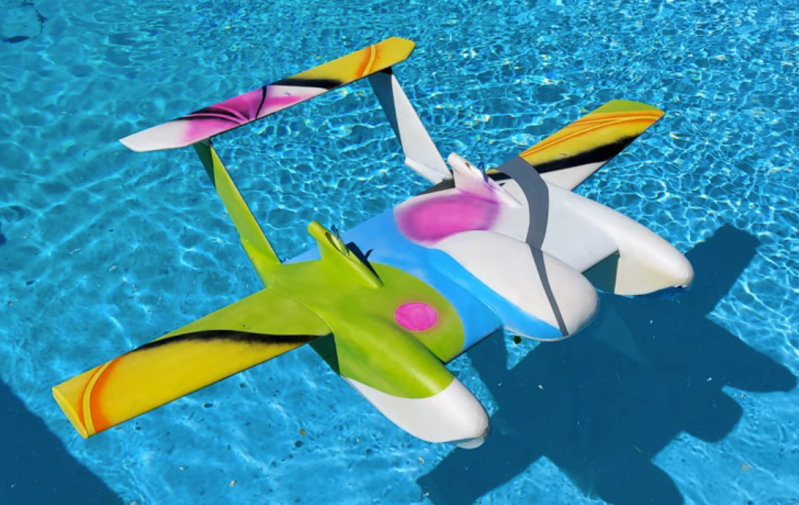There are a number of famous (yet fictional) sea monsters in the lakes and oceans around the world, but in the Caspian Sea one turned out to be real. This is where the first vehicles specifically built to take advantage of the ground effect were built by the Soviet Union, and one of the first was known as the Caspian Sea Monster due to the mystery surrounding its discovery. While these unique airplane/boat hybrids were eventually abandoned after several were built for military use, the style of aircraft still has some niche uses and can even be used as a platform for autonomous drones.
This build from [Think Flight] started off as a simple foam model of just such a ground effect vehicle (or “ekranoplan”) in his driveway. With a few test flights the model was refined enough to attach a small propeller and battery. The location of the propeller changed from rear-mounted to front-mounted and then back to rear-mounted for the final version, with each configuration having different advantages and disadvantages. The final model includes an Arudino running an autopilot program called Ardupilot, and with an air speed sensor installed the drone is able to maintain flight in the ground effect and autonomously navigate pre-programmed waypoints around a lake at high speed.
For a Cold War technology that’s been largely abandoned by militaries in favor of other modes of transportation due to its limited use case and extremely narrow flight tolerances, ground effect vehicles are relatively popular as remote controlled vehicles. This RC ekranoplan used the same Ardupilot software but paired with a LIDAR system instead of GPS to navigate its way around its environment.
Thanks to [TTN] for the tip!
















It doesn’t use an Arduino. It’s been a decade since the ArduPilot code actually ran on its namesake. Instead, it runs an a 32-bit ST-based Pixhawk autopilot
Fair enough.
How sure are you that it’s a Pixhawk?
It is using a Matek H743 running Arduplane, and could probably use and F7/H7 board that is compatible with Ardupilot.
Ardupilot runs on 32bit boards galore: https://ardupilot.org/plane/docs/common-autopilots.html
Pixhawk is not even the most common nowadays perhaps.
Impressive! How fast was your “monster” WiGing? Do you have any data on its efficiency when in WIG flight vs normal flight?
29mph airspeed. This is higher than it needs to be and RCTestFlight should be able to lower this by 5-6mph once he starts running his code on it with an altitude control sensor. No data on efficiency from me, this was just proof of concept and then quick hand off for him to continue the project, there will be a V2 on my end running the code he comes up with and I will have time for much data gathering.
The most interesting for me is that I learned of the existence of the ardupilot, which consists of source code (and wikis) for Air, Land and Water:
ArduCopter
ArduPlane
Rover
ArduSub
Antenna Tracker
And there is also PX4 (I mean software running on gazzilion boards, not the old PX4 board) which does not suffer from GPL and have much much more modular architecture.
Thanks interesting, it is primary hardware that adhere to the Pixhawk Standard:
https://px4.io/autopilots/
The first step in finding something is knowing that it exists!
Still the same problem as last time. The RC ground-effect planes are proportionally far lighter and way overpowered compared to their full-scale comrades, so they simply take off and instantly climb up far above the ground effect region which is only inches above the surface for the small wingspan. There’s no real buffer of air, they’re just controlled to fly low.
To really demonstrate the WIG effect properly, you’d need to put a ridiculously tiny motor and prop on it and then almost skim the water at a low speed. Problem is, even relatively calm waves are too big and force you to climb up, but the effect is completely lost after about a foot or two.
Did you watch the video at all? The free flight models were clearly “flying” only because of ground effect, (there are similar videos all over the internet) and those were far smaller than the UAV, which is easily supported by ground effect at throttle settings too low to fly out of ground effect. Yes they have to be overpowered because of the difference in hydrodynamics compared to full scale, but ground effect is operating just fine I can assure you.
Of course. The gliders did show the ground effect, and also flew much lower to the ground.
I too am somewhat skeptic, as to if they are flying very low with some downwash hitting the ground/water or if they’re flying below stall-speed with the weight of the plane supported by ground effect.
When I flew in ground-effect over a field, but mostly over water, I was able to throttle way back and was below stall-speed of the aircraft. A lot longer to get to where you were going, but as a hugely reduce fuel consumption. This Also required one know where the fences were over a field, and field size and what was between fields meant this had limited use where I was. Much nicer was over water, particularily the ocean. It needed rather calm days, and in addition to boats, one had to keep a close eye out for for seals and whales, as the floats were only one to three feet above the water’s surface. Turning with rudder, no banking.